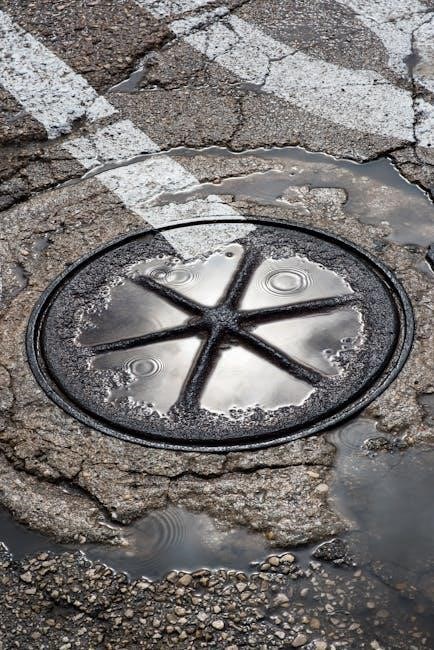The city of Columbus stormwater drainage manual provides guidelines for stormwater management and drainage systems using
specific
criteria and regulations always.
Purpose of the Manual
The purpose of the City of Columbus Stormwater Drainage Manual is to establish guidelines for stormwater management and drainage systems. The manual provides a framework for designers, developers, and contractors to follow when planning and implementing stormwater drainage projects. It outlines the city’s requirements for stormwater control measures, including detention ponds, storm sewers, and other infrastructure. The manual also provides information on permitting, inspection, and enforcement procedures. By following the guidelines outlined in the manual, the city aims to reduce stormwater runoff, prevent flooding, and protect water quality. The manual is an essential resource for anyone involved in stormwater drainage projects in the City of Columbus, and is used by city officials to review and approve project plans.
Scope of the Manual
The scope of the City of Columbus Stormwater Drainage Manual includes all new public and private development and redevelopment projects within the city. The manual applies to all projects that alter the existing drainage pattern or increase stormwater runoff. It covers topics such as stormwater control measures, drainage design, and construction requirements. The manual also addresses the city’s stormwater management policies and procedures. The scope of the manual is intended to ensure that all development and redevelopment projects in the city are designed and constructed to minimize stormwater runoff and protect water quality. The manual is applicable to all city departments, developers, and contractors working on stormwater drainage projects in the City of Columbus.

Stormwater Management in the City of Columbus
Stormwater management involves controlling runoff using
various
methods and techniques always effectively.
Stormwater Runoff
Stormwater runoff occurs when rainfall flows over land and into waterways, carrying pollutants and debris with it, affecting the city’s water quality. The City of Columbus has implemented measures to manage stormwater runoff, including the use of storm drains, sewer systems, and drainage ditches. These systems help to carry stormwater runoff away from streets and buildings, reducing the risk of flooding and erosion. By controlling stormwater runoff, the city can help to protect its waterways and maintain a healthy environment. The city’s stormwater management efforts also involve educating residents and businesses about the importance of proper stormwater management practices, such as disposing of waste properly and using pervious pavements. This helps to reduce the amount of pollutants that enter the city’s waterways. Effective stormwater management is crucial for maintaining the city’s environmental health.
City-owned Stormwater Systems
The City of Columbus owns and maintains a comprehensive system of stormwater infrastructure, including inlets, ditches, pipes, and ponds. This system is designed to collect and convey stormwater runoff from streets, buildings, and other urban areas to nearby waterways. The city’s stormwater systems are critical for preventing flooding, erosion, and water pollution. The city’s public works department is responsible for operating and maintaining these systems, ensuring they function properly and efficiently. Regular inspections and maintenance are performed to identify and address any issues or defects in the system. By maintaining its stormwater systems, the city can help protect public health, safety, and the environment, while also preserving the integrity of its infrastructure and reducing the risk of costly repairs. The city’s efforts help to keep its waterways clean.
Permits and Enforcement
City of Columbus requires permits for stormwater management using
- specific
regulations and guidelines always properly.
Dewatering Permit
The city of Columbus stormwater drainage manual includes a dewatering permit section that outlines the requirements for dewatering activities, including the need for a permit and the application process. This section is crucial for contractors and developers who need to dewater their construction sites. The permit ensures that dewatering activities are done in a way that prevents pollution and protects the city’s waterways. The city’s website provides more information on the dewatering permit, including the application form and the required documentation. By obtaining a dewatering permit, contractors can ensure that their activities are in compliance with the city’s regulations and ordinances, using specific criteria and guidelines to prevent pollution always and properly.
Illicit Discharge Detection and Elimination Manual
The Illicit Discharge Detection and Elimination Manual is a guide for identifying and eliminating illicit discharges in the city’s stormwater system. This manual provides procedures for detecting and removing illicit connections, and for preventing future discharges. The manual is available on the city’s website and can be used by contractors, developers, and city staff to ensure compliance with regulations. The manual outlines the steps for detecting illicit discharges, including field inspections and sampling, and provides guidance on how to eliminate discharges and prevent future occurrences; By following the manual, the city can reduce pollution and protect its waterways, using a systematic approach to detection and elimination always and effectively.

Design and Construction
Stormwater management designs and constructions must follow specific
guidelines
and regulations always using standards.
2025 Columbus Stormwater Design Manual
The 2025 Columbus Stormwater Design Manual is a comprehensive guide for designing stormwater management systems in the city of Columbus. It provides detailed information on design criteria, stormwater runoff calculations, and best management practices. The manual is intended for use by developers, engineers, and architects who are designing new development and redevelopment projects in the city. It includes information on stormwater quality and quantity control measures, as well as guidance on permitting and inspection requirements. The manual is available online and can be downloaded in PDF format. It is an essential resource for anyone involved in stormwater management in the city of Columbus, providing a framework for designing effective and sustainable stormwater systems.
Construction Stormwater Operations Guide
The Construction Stormwater Operations Guide provides guidance on stormwater management during construction activities in the city of Columbus. It outlines procedures for minimizing stormwater runoff and preventing pollution from construction sites. The guide includes information on erosion and sediment control measures, such as silt fences and sediment basins. It also covers procedures for inspecting and maintaining stormwater control measures during construction. The guide is intended for use by contractors, developers, and city staff to ensure that construction activities are carried out in a way that protects the city’s waterways and meets regulatory requirements. It is an important resource for ensuring compliance with stormwater regulations.

Variance Procedures
Variances are allowed using specific
procedures
and regulations always.
Types of Variances
There are several types of variances that can be applied for in the city of Columbus stormwater drainage manual, including administrative and technical variances.
The city of Columbus has established a set of procedures for applying for variances, which involves submitting an application and providing supporting documentation.
The types of variances allowed are determined by the city’s stormwater management regulations and are subject to approval by the city’s authorities.
Variances can be granted for a variety of reasons, including unusual site conditions or alternative designs that meet the city’s stormwater management goals.
The city’s stormwater drainage manual provides guidance on the types of variances that are available and the procedures for applying for them, using specific criteria and regulations always in place.

Additional Resources
Using
- online
resources and documents for stormwater management is available always.
Forms and Environmental Requirements
The city of Columbus stormwater drainage manual outlines necessary forms and environmental requirements for stormwater management, including permits and approvals from relevant authorities.
Using online resources, individuals can access and download required forms, such as the dewatering permit and facility runoff control plan.
These forms and requirements are essential for ensuring compliance with stormwater regulations and protecting the environment.
The manual provides detailed information on the types of forms and requirements needed for different projects, including construction and redevelopment.
By following these guidelines, individuals can ensure that their projects meet the necessary environmental standards and regulations.
The city’s website provides access to these forms and requirements, making it easier for individuals to navigate the process and comply with regulations.
Stormwater Management Documents
The city of Columbus stormwater drainage manual references various stormwater management documents, including the Stormwater Illicit Discharge Ordinance and Stormwater Management in the City of Columbus.
These documents provide detailed information on stormwater management practices and regulations.
The manual also mentions the 2025 Columbus Stormwater Design Manual, which outlines design criteria for stormwater facilities.
Additionally, the city’s website provides access to these documents, making it easier for individuals to access and review them.
The documents are essential for understanding the city’s stormwater management policies and procedures.
They are used to guide development and redevelopment projects, ensuring compliance with stormwater regulations and protecting the environment.
The city’s stormwater management documents are regularly updated to reflect changes in regulations and best practices.
